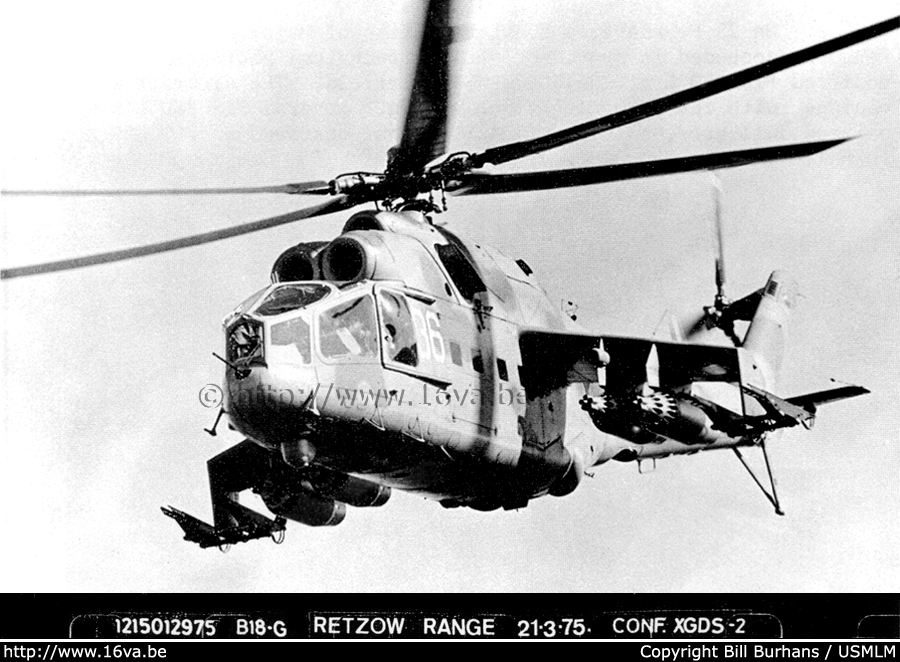

Voici la fameuse photo du Mi-24A n°36 réalisée à Retzow le 21 mars 1975, qui fut publiée à plusieurs reprises dans la presse aéronautique
occidentale au cours des années suivantes. Cet appareil vraisemblablement appartenant au 178.OBVP basé à Stendal, emportait quatre conteneurs lance-roquettes UB-32A.
La première version opérationnelle du Mi-24 n'était armée que d'une seule mitrailleuse nasale Afanasyev A-12,7. D'autre part, quatre rails pour autant de
missiles antichars 9M17M Falanga-M (Phalange) étaient montés à l'extrémités des plans - l'antenne de commande des missiles était quant à elle
abritée derrière le carénage fixé sous le nez.
Décortiquons les indications situées sous l'image :
1215012975 : le chiffre 1 indiquait que le Rapport de Renseignement et d'Information (Intelligence Information Report - IIR) avait été dressé par
un élément de l'Equipe Air de l'USAF (2 pour les
équipes de l'US Army et de l'US Navy et 5 si il s'agissait d'une photo provenant de la MMFL ou de BRIXMIS).
215
était le code de la USMLM (217 était utilisé pour les missions du programme "LARKSPUR" qui concernait les vols de reconnaissance au-dessus de la Zone
de Contrôle de
Berlin - Il semblerait que ce code n'ait été introduit que vers la fin des années soixante-dix).
012975 indiquait le numéro
du rapport (IIR 0129) pour l'année 1975 qui se rapportait à cette image. l'IIR était un compte rendu de la mission illustré avec des photos pertinentes.
Quand au moins une photo était utilisée, toutes les autres photos du rouleau étaient incluses avec le rapport. 34 films furent exposés ce jour-là,
mais ils ne furent pas tous attachés au
rapport. Les rouleaux non sélectionnés étaient détruits ultérieurement.
B18-G : B était le numéro du rouleau (n°2) et 18 le numéro de la photo. La lettre G probablement pour ground ou sol, indiquait que la
photo avait était prise du sol.
RETZOW RANGE indiquait le lieu où avait été prise la photo.
21.3.75. précisait la date quand la photo avait été prise.
CONF. signifiait Confidential.
XGDS-2 : ce code précisait quand la photo pourrait être "déclassifiée". Cet acronyme signifiait General Declassification Schedule-Category 2
ou Planning général de déclassification-catégorie 2.
Here is the famous picture of Mi-24A n°36 at Retzow on 21 March 1975, that was published several times in the Western aviation press during the
following years. That helicopter - probably of the 178.OBVP from Stendal - was carrying four UB-32A rocket launchers. The first operational version of the Mi-24 had only
one Afanasyev A-12,7 machine-gun in the nose. Four 9M17M Falanga-M (Phalanx) anti-tank missiles could be fixed to the rails mounted at the wingtips. The
fairing under the nose was hiding the command link transmitter antenna.
Let's have a look at the information under the image:
1215012975 : the digit 1 indicates that the Intelligence Information Report (IIR) was produced by the USAF Air Team element (2 for the US Army/Naval element
and 5 when the report came from
either FMLM or BRIXMIS).
215 was the code for the USMLM (217 was the code for the LARKSPUR aerial collection program flown in the Berlin Control 20-mile Zone - it seems that
this code was introduced
during the late 70s).
012975 indicates the report number (IIR 0129) for the year 1975 that was related to this image. The IIR was a mission report illustrated with pertinent pictures.
If at least one frame on a
roll was selected to be attached to a report, that entire roll of film (34 rolls were exposed this day, but not all of them were sent with the report)
was also included with the report. Rolls of
film from which no IIR photo attachments were selected were later destroyed.
B18-G : B was the roll number (n°2) and 18 was the frame number. The letter G probably incicates that the picture was taken from the ground.
RETZOW RANGE indicates the place where the picture was taken.
21.3.75. shows the date when the picture was taken.
CONF. meant Confidential.
XGDS-2 : that code specified when the picture could be declassified. The acronym stands for Exempt From General Declassification Schedule-Category 2.
